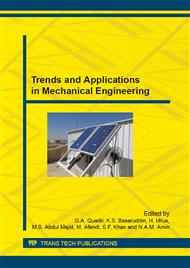[1]
R. Campilho, M. Banea, A. Pinto, L. Da Silva and De Jesus A.M.P., Strength prediction of single- and double-lap joints by standard and extended finite element modelling, International Journal of Adhesion and Adhesives, 31 (2011) , 363-372.
DOI: 10.1016/j.ijadhadh.2010.09.008
Google Scholar
[2]
J.M. Sally, C.B. Bayne, B. Robert, P.T. Antoni, W.M. Grayson, A review of adhesion science, Dental Materials 26 (2010) 11–16.
Google Scholar
[3]
T.L. Roberto, Adams, Composite Construction in Steel and Concrete VI, Devil's Thumb Ranch, Colorado, 2008, pp.670-671.
Google Scholar
[4]
W.F. Smith and J. Hashemi, Foundations of Materials Science and Engineering, 4th ed., McGraw's- Hill Book, 2006, pp.28-36.
Google Scholar
[5]
A.V. Adedayo, S.A. Ibitoye, and O.A. Oyetoyan, Annealing Heat Treatment Effects on Steel Welds, Journal of Minerals & Materials Characterization & Engineering, 9 (2010), 547-557.
DOI: 10.4236/jmmce.2010.96039
Google Scholar
[6]
B. Liscic, H. Tensi, W. Luty, Theory and Technology of Quenching, Springer-Verlag, (1992).
Google Scholar
[7]
K. Jacob, G. Russ, and S. Naomi, M. Becky, The Science and Engineering of Materials, (2003).
Google Scholar
[8]
N. Rahman, H. Roh, H. Qian, and C.T. Sun, Prediction of Failure Strength of Adhesive Joints Using Peel Stress and CTOA, Structural Dynamics and Materials Conference, Colorado, 19th (2011).
DOI: 10.2514/6.2011-1720
Google Scholar
[9]
M.J. Davis, A. McGregor, Assessing Adhesive Bond Failures: Mixed-Mode Bond Failures Explained, (2010).
Google Scholar
[10]
Q. Yao, J. Qu. Interfacial versus cohesive failure on polymer-metal interfaces in electronic packaging—effects of interface roughness, Journal of Electronic Packaging, (2002), 127-134.
DOI: 10.1115/1.1459470
Google Scholar
[11]
J.G. Teng, D. Fernando, T. Yu, and X.L. Zhao, Treatment of steel surfaces for effective adhesive bonding, Advances in FRP Composites in Civil Engineering, Springer Berlin Heidelberg, 2011, pp.865-868.
DOI: 10.1007/978-3-642-17487-2_190
Google Scholar
[12]
S. Aydin, S. Mercan, M.Y. Solmaz, and A. Turgut, Effects of adhesive thicknesses on the stress distribution in prismatic plug-in joints, International Journal of Physical Sciences, 8, (2013), 593-603.
DOI: 10.5897/ijps12.522
Google Scholar
[13]
F. Kahraman and A. Sagbas, An investigation of the effect of heat treatment on surface roughness in machining by using statistical anal, Iranian Journal of Science and Technology, Transaction B: Engineering, 34, (2010) 591-595.
Google Scholar
[14]
D.K. Diwivedi, A. Sharma, and T.V. Rajan, Machining of LM13 and LM28 cast aluminum alloy: Part 1, Journal of Materials Processing Technology, 196, (2008), 197-204.
DOI: 10.1016/j.jmatprotec.2007.05.032
Google Scholar
[15]
K. Uehara, M. Sarukai, Bonding Strength of adhesive and Surface Roughness of Joined Part, Materials Processing Technology 127 (2002) 178-181.
DOI: 10.1016/s0924-0136(02)00122-x
Google Scholar


